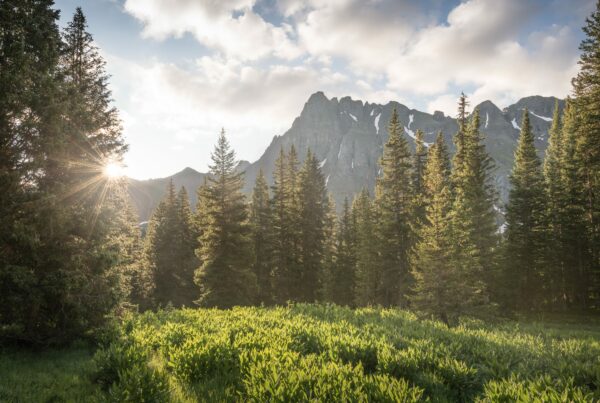BISMARCK, N.D. — Community, Tribal and environmental groups today filed a motion to intervene in a federal lawsuit from the states of North Dakota, Montana, and Idaho challenging the Bureau of Land Management’s new public lands rule, which creates a framework for the agency to manage 245 million acres for conservation. The coalition aims to defend the Bureau’s authority to adopt the long-awaited conservation rule from the states’ lawsuit.
The Bureau is guided by a multiple-use mandate, which it has implemented with a focus on extractive uses like fracking, mining, grazing, and logging. The new rule, finalized in April, appropriately recognizes conservation as a use in this context, better positioning the agency to manage public lands to serve as a cornerstone of ecological and community resilience in the face of a changing climate.
“It comes as no surprise that certain states hostile to conservation are suing to prevent the Bureau of Land Management from considering conservation of public lands alongside mining and fracking,” said Barbara Chillcott, senior attorney at the Western Environmental Law Center. “We are asking the court to allow us to make the case that modernizing public lands management for conservation and climate protection in the 21st century completely adheres to the broad authority and responsibility the agency bears under well-established law. The public lands rule will serve as a key tool to help the U.S. meet its climate goals. We are decades behind on reaching them.”
“The Bureau of Land Management public lands rule can help North Dakota to reach Gov. Burgum’s admirable goal to become carbon neutral by 2030,” said Shannon Straight, Badlands Conservation Alliance executive director. “North Dakota public lands and waters, including our iconic grasslands, are a vital habitat for wildlife and fish that feed our growing recreation economy and sustain a way of life in western North Dakota. Grasslands store carbon naturally in their deep root systems and are a dwindling natural resource due to the impacts from extractive industries. Implementation of the public lands rule would make public lands across the country more resilient to climate change which will help offset the impacts from decades of oil and gas development within North Dakota and the decades of development on the horizon.”
“Decisions made at the federal level will affect federally recognized tribes and shared cultural resources. We cannot allow any move by fossil fuel interests that might weaken the best federal regulation for our shared resources, lands and communities,” said Robyn Jackson, executive director of Diné C.A.R.E. “Management of public lands should reflect present pressing concerns around climate and its impacts to the many living communities and ecosystems relying on these public lands. We must defend the advancements the rule offers for Indigenous environmental justice concerns, conservation, reclamation, and co-stewardship with tribes.”
“The Federal Land and Policy Management Act (FLPMA) includes conservation of natural and cultural resources in its multiple use mandate,” said John Rader, public lands program manager at the San Juan Citizens Alliance. “But for decades the Bureau of Land Management has prioritized extractive industry at the expense of our ecosystems and communities. The public lands rule elevates conservation so the Bureau can fulfill FLPMA’s mission and manage our resources responsibly.”
“For too long the Bureau of Land Management has sacrificed our public lands to industry extraction, but this new rule begins to set things right and we’re eager to defend it in court,” said Randi Spivak, public lands policy director at the Center for Biological Diversity. “Congress intended these lands to be managed for conservation as part of its multiple-use mandate. The states fighting this rule care more about shilling for corporations than conserving wildlife, rivers, forests and canyons for future generations.”
“The Bureau of Land Management is the largest manager of public lands in the United States, and it has a critical role in the effort to take on the climate crisis,” said Dan Ritzman, director, Conservation Campaign at Sierra Club. “For years, the Bureau managed public lands to maximize extraction and profit over conservation, cultural values, and enjoyment, and some want to make sure it stays that way. We need an energetic Bureau that truly upholds its multi-use mandate – including conservation – not one that privileges industry and extraction.”
“Public lands are ingrained in the lives of so many people that live in these states,” said Chris Krupp, public lands attorney at WildEarth Guardians. “They want more wildlife, not less. They want favorite landscapes that aren’t threatened with industrial extraction. They want public lands conservation. We’re seeking to intervene in these lawsuits to defend the Rule from state leaders whose overriding concern is corporate profits rather than their residents’ values.”
“For too long the use of public lands for extractive industries has contributed to ecological decline and the climate crisis,” said Natasha Léger, executive director, Citizens for a Healthy Community. “This rule is a step in the right direction to right these wrongs and protect communities like the North Fork Valley in Southwest Colorado, where local warming has already reached 2.1 degrees Celsius. We look forward to defending the Bureau of Land Management’s authority to elevate conservation nearer the level of extractive industries.”
The new rule is wildly popular, with 92% of comments submitted to the Bureau in support of elevating public lands conservation. Eighty-two percent of voters in the Rocky Mountain West support a national goal of conserving public lands and waters in the next decade, including more than two-thirds of conservative Republican voters.
In addition to the public comments, members of Congress, local elected officials, legal scholars, scientists, attorneys general, former Bureau of Land Management officials, hunters and anglers and more than 100 businesses support the Bureau’s public lands rule.
The rule upholds the Bureau’s mission to manage public lands for conservation as both the trustee of federal public lands for the benefit of the American people and the regulator of federal public lands uses, according to WELC experts, eight state attorneys general, and 27 law professors. Valid existing rights to graze, mine, and drill will not be affected by the rule’s core provisions.
Public lands are a major contributor to climate change. For decades, the agency has favored extractive uses to an extreme degree, as exemplified by the 90% of its public lands the Bureau has made available for oil and gas leasing. Fossil fuel extraction from federal public lands is a significant source of greenhouse gas emissions and associated climate and community impacts.
The Interior Department’s highly permissive approach to oil, gas and mineral extraction on federal public lands has undercut the nation’s ability to deliver on its climate commitments. Oil and gas companies own leases conveying the right to drill 26.6 million acres of federal public lands and minerals. Although nearly 53% of those leased acres are non-producing, 96,000 wells have already been drilled and the Interior Department has approved, without imposing any climate mitigation measures, an industry stockpile of more than 9,000 additional drilling permits.
Background:
The Bureau of Land Management oversees 40% of all public lands—245 million acres primarily in the western U.S. With its public lands rule, the Bureau is exercising its longstanding authority and responsibility under the Federal Land Policy and Management Act (FLPMA) to conserve a portion of these public lands in the public interest. The Act defines “multiple use” as management that “takes into account the long-term needs of future generations for renewable and nonrenewable resources,” including “watershed, wildlife and fish, and natural scenic, scientific and historical values.” 43 U.S.C. § 1702(c).
The public lands rule is the Bureau’s first set of comprehensive regulations designed to conserve public lands under its jurisdiction, defining conservation as a multiple use alongside extractive and consumptive uses, and providing a framework and suite of tools to advance conservation on public lands. The rule has the potential to preserve and restore public lands through, among other things, increased Area of Critical Environmental Concern designation, identifying and preserving intact landscapes, instituting widespread land health standards, undertaking restoration planning, and creating a new leasing program focused on restoration and mitigation.
FLPMA stipulates public lands be managed to “protect the quality of scientific, scenic, historical, ecological, environmental, air and atmospheric, water resource, and archeological values,” and “preserve and protect certain public lands in their natural condition” where appropriate. 43 U.S.C. § 1701(a)(8). Further, FLMPA directs that, in managing public lands, the Bureau “take any action necessary to prevent unnecessary or undue degradation of the lands.” 43 U.S.C. § 1732(b).
The Bureau’s obligation to manage for multiple use “does not mean that development must be allowed.” New Mexico ex rel. Richardson v. Bureau of Land Mgmt., 565 F.3d 683, 710 (10th Cir. 2009). Rather, conservation and development are coequal possible uses that the Bureau must balance in managing public lands.
Contacts:
Barbara Chillcott, Western Environmental Law Center, 406-430-3023, chillcott@westernlaw.org
Shannon Straight, Badlands Conservation Alliance, 701-450-1631, bca@badlandsconservationalliance.org
Robyn Jackson, Diné C.A.R.E., 928-228-5805
John Rader, San Juan Citizens Alliance, 970-259-3583, john@sanjuancitizens.org
Ian Brickey, Sierra Club, ian.brickey@sierraclub.org
Randi Spivak, Center for Biological Diversity, 310-779-4894, rspivak@biologicaldiversity.org
Chris Krupp, WildEarth Guardians, 206-417-6363, ckrupp@wildearthguardians.org
Natasha Léger, Citizens for a Healthy Community, 970-399-9700, natasha@chc4you.org




